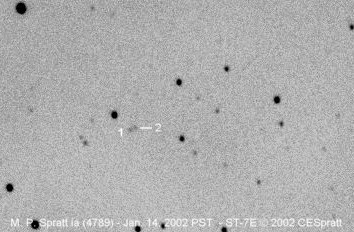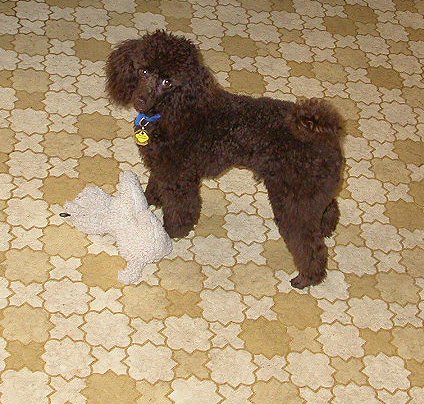
I'm a "Unattached member" of the Royal Astronomical Society of Canada. I've been residing in Victoria since 1976. Ive been a member of the Niagara Falls, London, Ottawa and Victoria Centres of the RASC.
I've been a member of the AAVSO since 1961 and have contributed over 33,000 (visual) variable star estimates. Most of my visual observing was done with an 8" Celestron (vintage 1976) f/10 Schmidt-Cassegrain telescope. For many years, I've been searching (visually)for comets and supernovae. But, alas, without success! (NOTE: This scope was sold in January 2004.)
In June, 1999, I acquired a Celestron Pixcel 237 CCD (made by SBIG) and started an astrometry program. In late September 1999, I was assigned Observatory Code 642 (Oak Bay, Victoria).
The telescope, I then used, in the beginning was the same old (vintage 1976) Celestron 8" f/10 Schmidt-Cassegrain, but with a SBIG focal-reducer which gave me either f/3.7 or f/4.7 using the Pixcel 237. The field of view with this setup was approximately 17'.0 x 12'.8 (F/4.7) or 21'.7 x 16'.3 at F/3.7. On good nights, I was able to reach magnitude 17.5 (CCD visual) but such nights were/are very rare. The OTA was orginally mounted on an Astro-Physics 400 QMD equatorial mount (non-GOTO). This was replaced with a new Astro-Physics 600E GOTO mount in March , 2000.
The AP600E is a piece of craftsmanship! Still portable but much easier to get a good polar alignment and thus longer images without drifting due to poor alignment.
With this particular setup, I'm rather limited in the number of objects I can image any one night as the equipment is portable. Meaning, I have to assemble and then dismantle everything each observing session. Thus imaging and measuring 6-7 different objects per night is the norm.
In October, 2000 - The Pixcel 237 CCD was replaced by an SBIG ST-7E CCD, which with the focal reducer on the 8" OTA gave a Focal Ratio of F/5.2 and a field of view of 22' by 15'. The limiting magnitude was still around magnitude 17.5 due to the light pollution from my observing site.
NOTE: (October 25th, 2000) - The AP600E GOTO mount has allowed me to increase "throughput". But there are so many asteroids and so little time!
The latest version (3.0+) of the planetarium program "The Earth Centered Universe - ECU", which I "beta-tested with the AP600E, allows me to click on the asteroid or comet I wish to image and the scope will slew and center on that object. (I've tried other programs "The Sky", "SkyMap Pro 6.0" but for me "ECU" works the best.)
NEWS: (March/May, 2001) - A new Celestron 9.25" F/10 OTA arrived, and should be in complete operation by the end of April (turned out to be June). Full operational use has been delayed due to the late arrival of the required Losmandy dovetail adapter bar. This is required to attach the OTA to the mount. The present bar, on the OTA, as supplied by Celestron is no longer the Losmandy one. This new Celestron bar is much narrower and isn't the one as pictured in Celestron's advertisements a few months back. At that time, the C9.25" was/could be supplied with the Losmandy G11 (Celestron version).
I did have the narrow bar modified (drilled) locally so I could attach the Astro-Physics bar. However, this modification, although to my specifications, results in the OTA being very "back-heavy" and thus very hard to balance. Some astrometry work, however, at F/5.6 with a focal reducer was done. The program was now back in full operation.
After a short trip to California in May, 2001, I brought back the required Losmandy Dovetail Bar and it works very well. I can now balance the C9.25 with the ST-7E CCD and focal reducer (F/5.2 August 2003) hanging on the back. I've also discovered that the Astro-Physics 600E GOTO GEM can just handle the C9.25 with the ST-7E CCD etc. hanging on the scope's back-end A larger mount is really needed (the AP900 or AP1200 would be better). If I ever can afford to get the Apogee AP7P (SiTe based CCD), I will be able to dispense with the focal reducer and associated couplings as this model CCD works best at F/10. This may "lighten" the load enough that the AP600E won't be so overtaxed.
In any case, with this improved observational efficiency (slightly larger OTA), I've been continuing my "follow-up" imaging of new Near Earth Asteroids (NEA's) and comets, and any minor planets on the "Critical List" of the Minor Planet Centre and Lowell Observatory, on a regular basis (weather permitting). I can attain magnitude 18.5 on good nights.
For astrometry processing
I've used
two programs Herbert Raab's "Astrometrica" (the new Windows version)
which I was "Beta-testing (in June, 2001). This program is now
available as "registered version" (November, 2002). I've also used
Brian Warner's "Canopus" version 7 and this also gives very good
results.
Astrometrica also allows me
to "track
& stack" images. This "pushes" the magnitude limit I can reach to
almost
19. With more images I may be able to get down to 19.5 or better.
In June 2002, I retired from
working at the University of Victoria as Grounds Supervisor - this may
help
me to devote more time to my astronomy activities if the weather is
favourable! On the other
hand, my model railroad
project helps to fill in those rainy nights! It seems that I have too
many hobbies and so
little time!
NOTE:
(May, 2005) Due to failing health the astrometry program (and observing
site #642) was shut down in early 2005. I will be moving into a
townhouse in July so any astronomical work will be visual. It has been
a great fun though.
Some Honours and Awards:
I received the Royal Astronomical Society of Canada Victoria Centre Membership Certificate in 1979 for services to the local centre.
Recipient of the Royal Astronomical Society of Canada Ken Chilton Prize in 1983 for variable star observations.
"The Ken Chilton Prize was established in 1977 in memory of K. E. Chilton of Hamilton, and is awarded annually to an amateur astronomer resident in Canada, in recognition of a significant piece of work carried out or published during the year."
Recipient of the Royal Astronomical Society of Canada Chant Medal in 1988 - for my nearly three decades of astronomical observing.
"The Chant Medal of the Society was established in 1940 in appreciation of the great work of the late Professor C. A. Chant in furthering the interests of astronomy in Canada. This medal is awarded, not oftener than once a year, to an amateur astronomer resident in Canada on the basis of the value of the work which he has carried out in astronomy and closely allied fields or original investigation."
I received a Merit Award for my meteorite display at the R.A.S.C., A.S.P. and W.A.A. Joint General Assembly held at the University of Victoria in June 1998.
Minor Planet (4789) - 1987
UU2 was
named SPRATTIA in my honour (June 27,
1991). This asteroid, a member of the Flora family, was the first
numbered
minor planet to have been discovered in Canada (by D. D. Balam at the
Climenhaga Observatory of the University of Victoria). I hope to image
this particular minor planet in the near future.
NOTE: In the summer of 2000,
"Sprattia" was too low from my observing site (trees etc.), so I missed
the opportunity to image at that opposition. However, I was successful
in obtaining images on two nights in early 2002. Here is one from
January 14, 2002 (PST) showing movement towards the north over several
minutes.

I received the Observers Award, in May 1994, from the AAVSO for my 25,000+ variable star observations made from 1961 to 1993.
Memberships
Non-Astronomical Clubs (Other Interests)
And a final word -

Another hard day at the non-astronomical UVic. office!

My little helper "Zoey" at 7 months and her best
friend